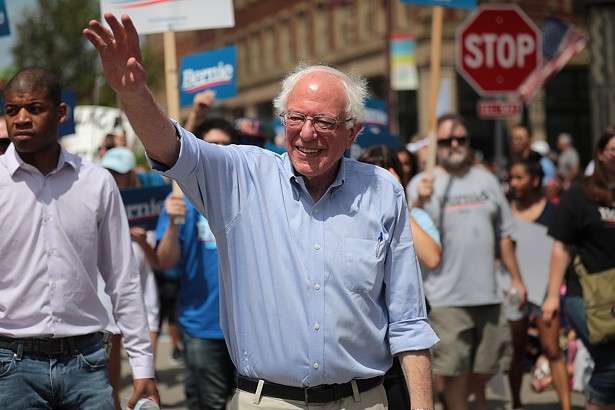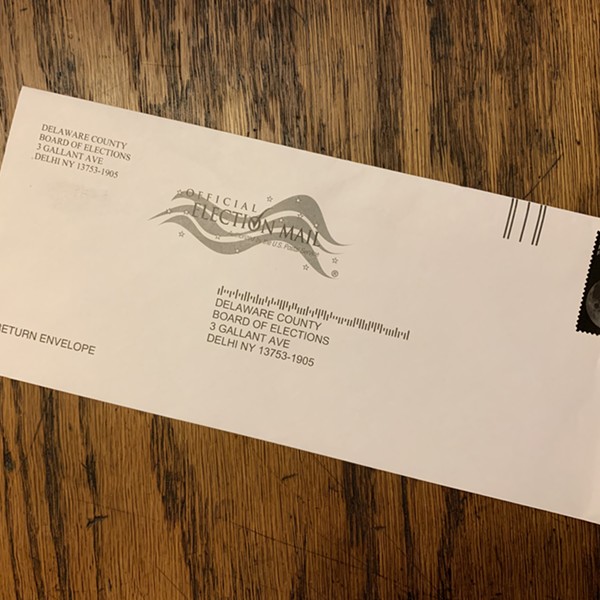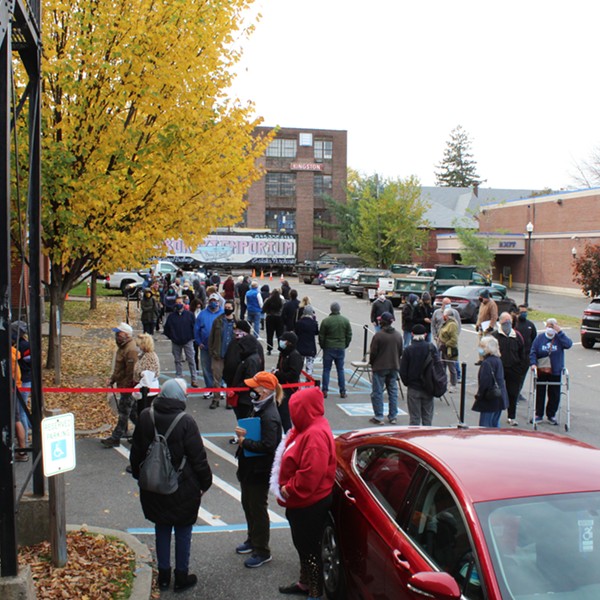On Tuesday in New Hampshire, voters cast their ballots in the presidential primaries, the second electoral contest of 2020. In a welcome change from the first one, we actually got results in a straightforward and timely fashion: the Associated Press called the race for Vermont Senator Bernie Sanders shortly before midnight.
Coming on the heels of a virtual tie in Iowa and with advantages in national polls, fundraising, and ground game (his volunteers knocked on doors at 20 percent of all homes in New Hampshire on the Saturday before the primary), Sanders’s win in the Granite State positions him as the frontrunner for the 2020 Democratic presidential nomination. According to FiveThirtyEight’s projection model—which, if history has taught us anything, should be taken with a grain of salt—Sanders has a 37 percent chance of reaching a pledged delegate majority, a clear 20 percentage points ahead of the second-most-likely nominee, Joe Biden.
But the most-likely outcome is that the Democrats arrive at the convention on July 13 in Milwaukee with no one having secured a delegate majority. That could lead to a contested convention in which the nomination is in doubt.
If you’re rooting for this chaos, New Hampshire gave you something to cheer for: Sanders won by less than 2 percent over former South Bend mayor Pete Buttigieg, with Minnesota Senator Amy Klobuchar “Klobucharging” to a strong third-place finish. Former frontrunner Joe Biden finished a distant fifth, with Elizabeth Warren in fourth. (The primary was the end of the line for Tom Steyer and Deval Patrick, as well as Andrew Yang, who’d staked his campaign on a strong finish in New Hampshire.)
The results in New Hampshire indicate that the battles over ideology and electability that have defined the Democratic race thus far are a long way from being resolved. Sanders’s case for beating Trump in the general election is that his candidacy will turn out new and young voters, but that hasn’t really happened thus far. It might in the larger, more diverse states still to vote, but that remains to be seen.
Meanwhile, the moderate candidates between them have gathered a majority of the votes in Iowa and New Hampshire. Their problem is that the long-time frontrunner, Biden—whose campaign is based on his electability—has still never finished higher than fourth in a caucus or primary in three presidential runs over the last 32 years. Buttigieg and Klobuchar have taken his support, but it seems unlikely either can go the distance: they poured all their resources into the first two states, have little support from people of color, and have fundraising deficits when compared to Sanders—to say nothing of former New York City mayor Michael Bloomberg, who’s already poured $200 million of his own money into his campaign.

Because of his late entry into the fray, Bloomberg has not been on the ballot in the early voting states. But his presence looms increasingly large as the one moderate around whom Democrats could coalesce. Bloomberg has mostly avoided scrutiny so far, but that’s starting to change in accordance with his apparent viability. This week, an audio clip circulated online in which Bloomberg is heard discussing in clearly racial terms the stop-and-frisk policing method he supported as mayor.
“Ninety-five percent of your murders—murderers and murder victims—fit one MO. You can just take the description, Xerox it, and pass it out to all the cops,” Bloomberg says. “They are male minorities, 16 to 25. That’s true in New York. That’s true in virtually every city. And that’s where the real crime is. You’ve got to get the guns out of the hands of the people that are getting killed.”
Bloomberg apologized, but the next day, video emerged from a 2008 forum at Georgetown University during which Bloomberg blamed the recession on the end of “redlining,” the discriminatory housing policy that made it difficult for people of color to qualify for mortgages. “It all started back when there was a lot of pressure on banks to make loans to everyone,” Bloomberg said. “Redlining, if you remember, was the term where banks took whole neighborhoods and said, ‘People in these neighborhoods are poor, they’re not going to be able to pay off their mortgages, tell your salesmen don’t go into those areas.’
“And then Congress got involved, local elected officials, as well, and said ‘Oh that’s not fair, these people should be able to go get credit.’ And once you started pushing in that direction, banks started making more and more loans where the credit of the person buying the house wasn’t as good as you would like.”
The former mayor has built his campaign by paying enormous salaries and throwing lavish events, and recently he’s attempted to bolster his image by paying social media influencers to make memes on Instagram.
But further scrutiny of his record is inevitable (the national media has barely discussed the NYPD Muslim surveillance program that Bloomberg defended, for starters). Writing for The New Republic, Alex Pareene argues against Bloomberg’s “polite authoritarianism”:
Michael Bloomberg is precisely the sort of person who should be kept out of power, in large part because so many Americans are comfortable with his genteel authoritarianism. Donald Trump understood the true purpose and meaning of stop-and-frisk, which he extolled to cops in 2018. It’s alarming to see Democrats considering nominating someone who expressed the same ideas in a calmer tone.
The Democratic Primary Slog
All of this unpredictability and fluidity points to one macro-level takeaway: It’s going to take a while yet to settle this race. New York is one of the last states to vote (on Tuesday, April 28), but it’s highly probable that no Democratic candidate will have secured a pledged delegate majority by that date.
New York votes with Connecticut, Delaware, Maryland, Pennsylvania, and Rhode Island in the “Acela” primary. It’s the last big voting day of the race, and a dominant performance by a single candidate might be enough to push them over the edge in the delegate race, or at least unify party support. In that event, New York—as the largest state remaining on the calendar, with 274 delegates up for grabs—may have an unusually large say in determining the Democratic nominee for president.
Good thing, then, that the state passed comprehensive election reform last year, overhauling some of the most restrictive voting laws in the nation. Among the changes: allowing early voting and preregistration of high schoolers so they’re automatically enrolled to vote upon turning 18, and consolidating state and federal elections, which were previously held in different months. The package also authorized constitutional amendments to allow same-day registration and “no excuse” absentee voting—which must be approved by voters at a later date.
The reforms were long overdue for a state with a progressive reputation but a laughably poor track record of voter participation and election competency. New York routinely ranks near the bottom in turnout (42nd in 2018), was one of only 13 states to not allow early voting, and has been plagued by problems like voting machines breaking down, voters not appearing on or being wrongly purged from registration rolls, and convoluted rules such as requiring voters who wish to change their party affiliation to do so more than a year before the election. The reforms gave New York some of the best voting laws in the US, as Mother Jones reports: “At a time when many Republican-controlled states are making it harder to vote, New York is part of a broader trend of states pushing back on GOP voting restrictions.”
This year contains the first set of elections where we can truly measure the impact of the reforms. (And remember: in New York, you are not required to have photo identification at the polls.) Here are the deadlines to know:
April 28 Presidential Primaries
- Mail-in registration must be postmarked no later than April 3
- In-person registration must be done by April 3
- Change of address notifications from registered voters must be received by April 8
- Changing your party enrollment for the closed primary must be done by February 14
June 23 State and Federal Primaries
- Mail-in registration postmark: May 29
- In-person registration: May 29
- Change of address: June 3
- Change of party enrollment: February 14
November 3 General Election
- Mail-in registration: October 9
- In-person registration: October 10
- Change of address: October 14
If you plan to absentee vote in the presidential primary, April 21 is the last day to request a ballot by mail, and April 27 is the last day to postmark your ballot. Learn more at the New York State Board of Elections homepage.
Phillip Pantuso is the editor of The River, and has contributed to the Guardian, the New York Times, and Yes! Magazine. Follow him on Twitter @phillippantuso.


















